Nigeria’s H1 2025 Economic Review and H2 Outlook: Bridging the Transition Gaps

Recent developments in the trade policy of the United States (US) have introduced uncertainty as a make-or-break factor for nations across the globe. The associated disruptions for most nations have generated significant shifts in economic trends, as prospects for a stable economy falter while market volatility heightens. The series of tariffs, threats, and negotiations has modified the trajectory of the international trade system, resulting in increased uncertainty. A previously endorsed pathway toward peace, which could have mitigated conflicts, now appears less feasible as international tensions escalate, thereby risking supply chains, reducing demand owing to higher prices, and impeding overall economic growth.
Recovering or growing economies remain vulnerable, and their capacity to continue expanding is continually tested. Nevertheless, each economy remains cautious and advances prudently in actions and reactions to sustain global trade, partnerships, and the associated benefits.
Global Geopolitics Flashpoints
The global economy has experienced numerous transformations following various political disturbances. It is crucial to recognise that macroeconomic factors are not the sole significant drivers of these global disruptions; there is also a strong correlation with political interests and defences. Global geopolitics has swiftly necessitated that many emerging and developing nations develop robust foundations to counteract increasing challenges (see Table 1 below).
Table 1:
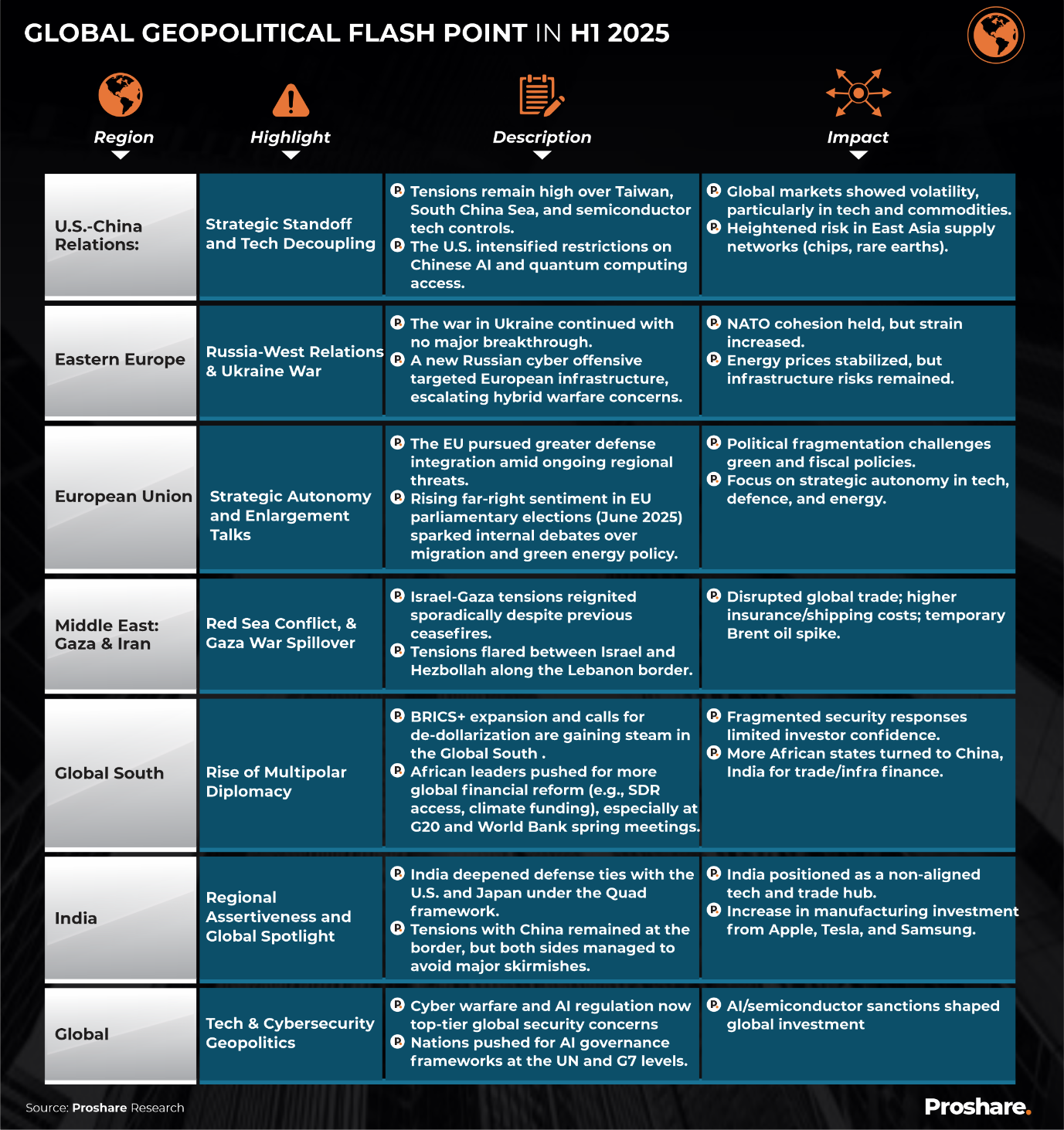
Snapshot of Expectations from Global Analysts
In 2025, global institutions forecasted cautious economic growth, with GDP growth projected to be between 2.3% (World Bank) and 4.7% (Goldman Sachs). Inflation may ease, but the IMF’s 5.5% forecast shows ongoing risks. Monetary policy may shift with steady or easing interest rates, potentially bringing an end to the global tightening. Overall, 2025 appears stable, with resilient growth and gradual inflation and rate normalisation (see Table 2 below).
Table 2:

African Economic Flashpoints
In the first half of 2025, the African economy exhibited both vulnerabilities and resilience. Global disruptions, caused by geopolitical tensions, trade conflicts, immigration restrictions, and tariffs, heavily impacted key economies. Recovery efforts were hindered by political instability in the Sahel, energy challenges in South Africa, political/social discontent in Eastern Africa, and climate-related agricultural disruptions. Inflation averaged 13.8%.
Rising public debt remained a key area of concern for the economy, and currency depreciation burdened countries like Nigeria and Egypt. Conversely, for economies such as Ghana, the currency stood out as the best-performing in Africa, following the success of debt restructuring, firming commodity prices, reduced speculative activity in the foreign exchange market, and central bank liquidity interventions.
On a positive note, Inflation pressures moderated mainly across Africa, despite US global trade tariff threats amidst strong recovery in continent’s average GDP growth rate reached 3.9%at the endof2025, driven by strong performances in the services, mining, construction and tourism, particularly in Central North Africa where economies such as Morocco saw a +19% tourism sector growth in H1 2025. Additionally, the AfCFTA is beginning to show early benefits, as tariff reductions and harmonised trade rules facilitated more cross-border trade among African countries in H1 2025 (see Table 3 below).
Table 3:

East Africa is expected to drive GDP growth mainly through strong performances in services, agriculture, and infrastructure, with Ethiopia, Kenya, Rwanda, and Uganda playing key roles. North Africa leads in foreign direct investment (FDI), with significant investments in energy, infrastructure, industrial sectors, and tourism, especially in Egypt, Algeria, and Morocco. Although Southern Africa has the most developed capital markets, the region faces challenges related to investor confidence caused by policy issues, political conflicts, slow economic growth, and high debt levels. West Africa remains somewhat in the middle, although rising debt and currency risks continue to cause concern (see Illustration 1 below).
Illustration 1:
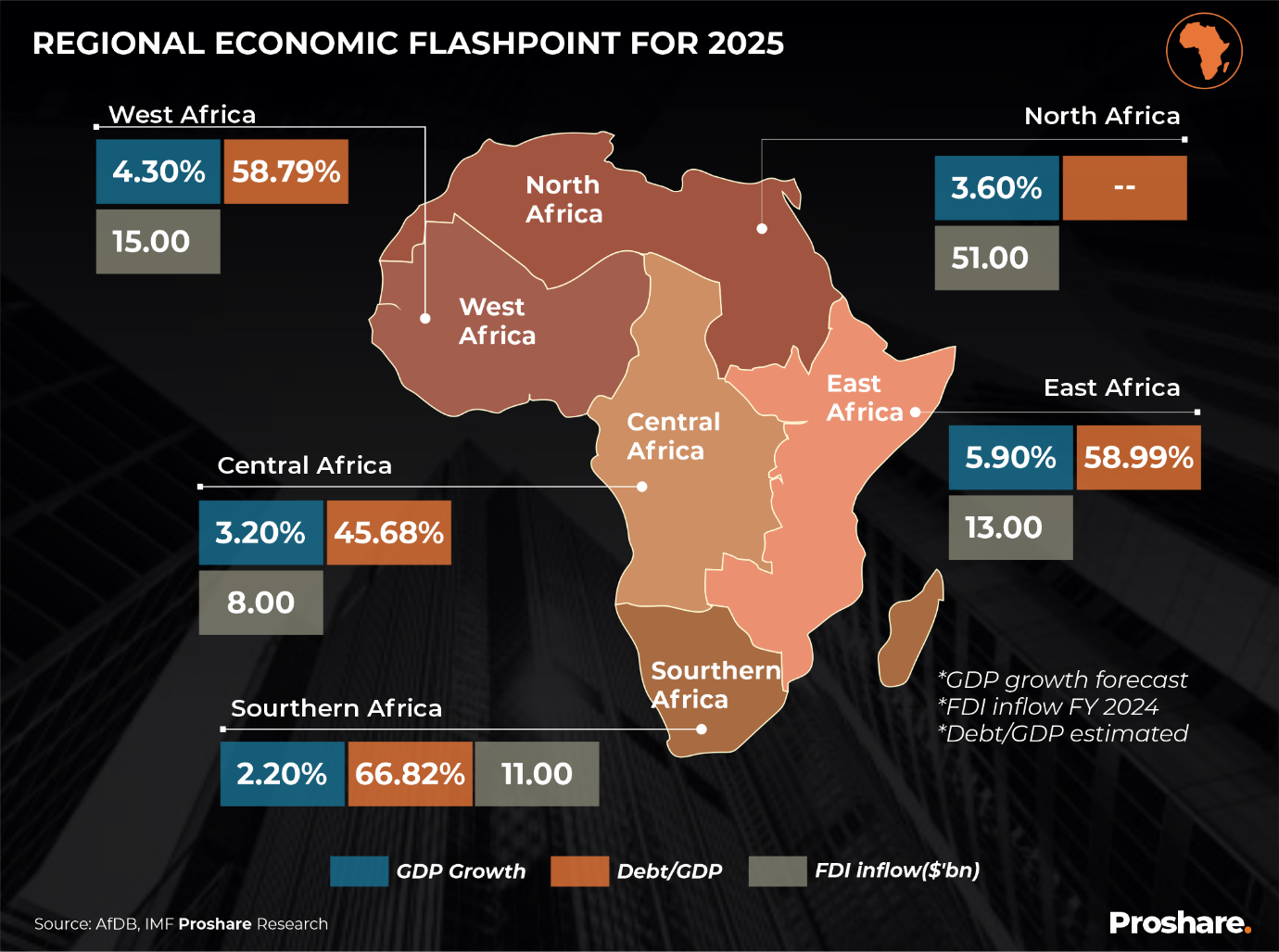
Snapshot of Analyst Expectations for the African Economy in 2025
Multiple institutions have issued assessments and set expectations regarding the African economy. These institutions agree that Africa’s economy is on a gradual recovery path; however, external vulnerabilities and inflationary pressures may cause deviations from this path. While a more positive growth outlook has been forecasted, risks such as exposure to global volatility require close monitoring. Overall, although steady growth is expected, managing inflation and implementing structural reforms are crucial to maintaining macroeconomic stability (see Illustration 2 below).
Illustration 2:
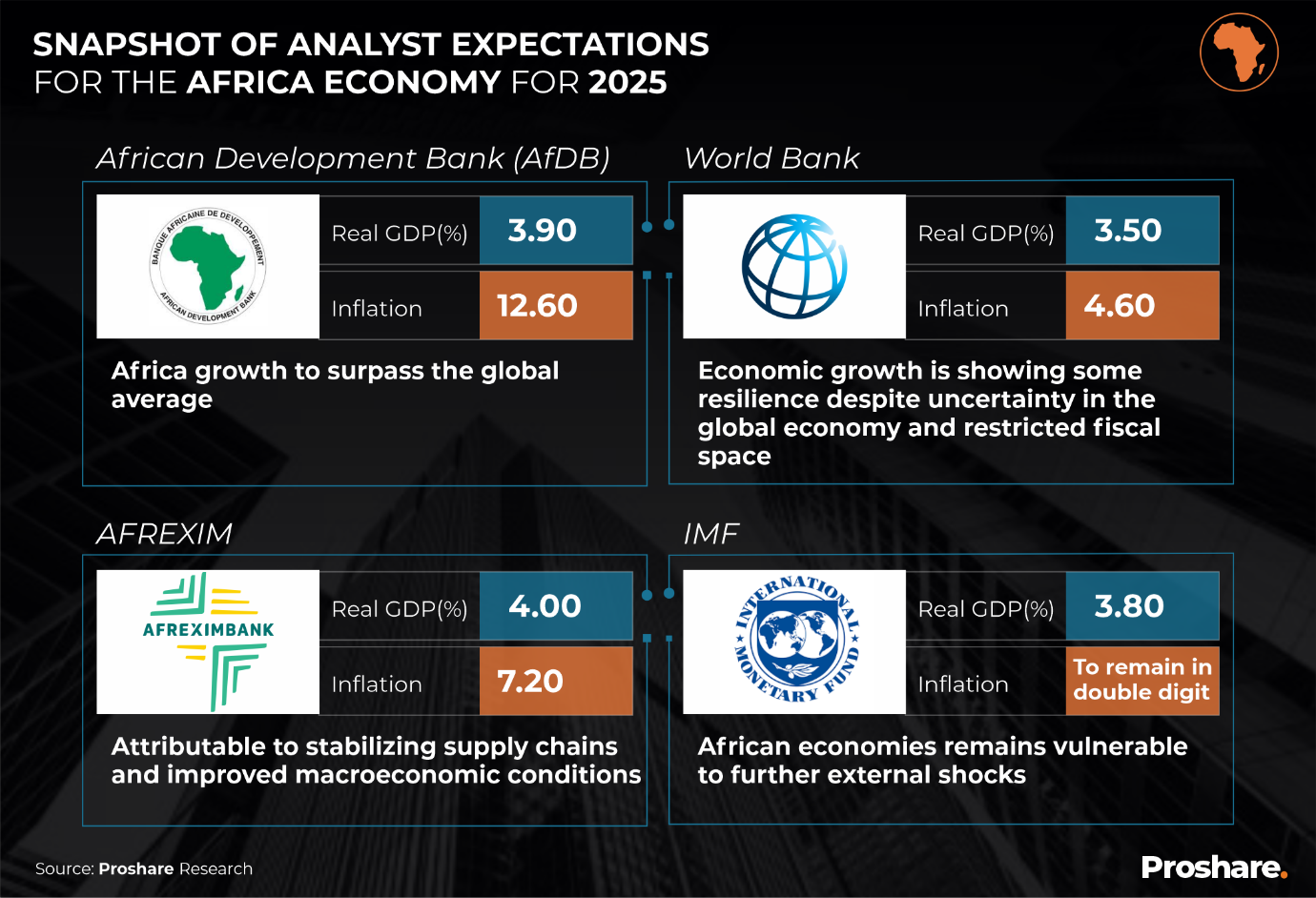
The Nigerian Economy in H1 2025
The Nigerian macroeconomic landscape remained stable in the first quarter of 2025, despite external and domestic market volatilities. The period was marked by broad-based external market disruptions due to geopolitical uncertainties, trade tariff tensions, and immigration policies of the United States President, Donald Trump, which led many economists/analysts to project higher inflation and an economic slowdown.
On the other hand, the domestic economy faced heightened challenges due to insecurity in the nation’s major food production belts, energy/power challenges, elevated borrowing costs, liquidity risk, and climate risk from floods. However, the perception of relative macroeconomic stability, along with policy signalling and ongoing structural reforms, played a critical role in sustaining positive sentiment among households and businesses during the period (see Chart 1 below).
Chart 1:
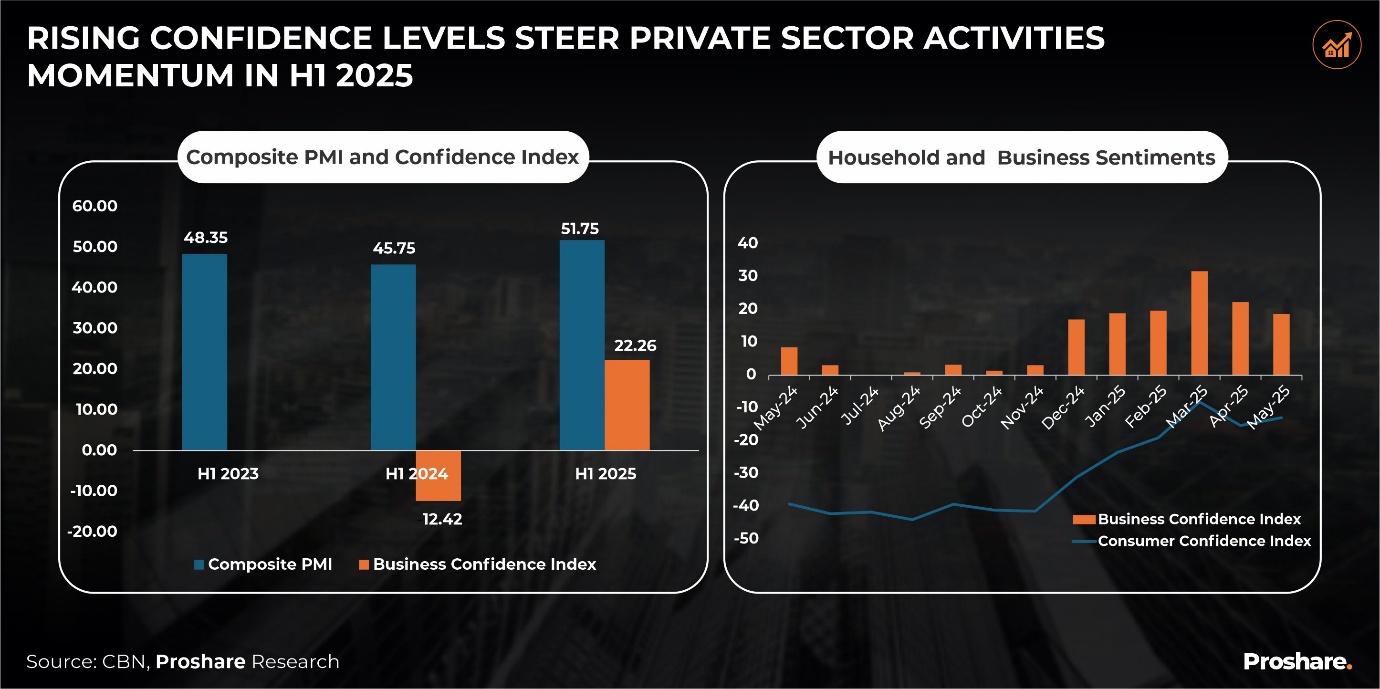
Nigeria Macroeconomic Dashboard and Outlook for H2
Overall, macroeconomic conditions showed higher performance in H1 2025 relative to the same period over the last two years. Specifically, conditions within the period indicate moderation in inflation pressures; the foreign exchange (FX) market remained stable (unified) across official and parallel markets due to increased transparency and governance, improvements in disclosure, greater discipline, technology integration, and policies of the Central Bank of Nigeria reducing FX market volatilities. Additionally, Crude oil production was higher, and the foreign trade balance remained in surplus for the tenth consecutive quarter.
Nonetheless, fragilities emerged due to low global crude oil prices, posing a significant risk to the government’s revenue targets and its ability to meet fiscal obligations, resulting in a higher appetite for debt and a nearly 50% increase in the domestic debt market size over the last year. The observed fragilities in the period are largely structural and fiscal, aligning with concerns raised in the recent IMF Article IV report. The report commends the CBN’s monetary policy actions and the stability achieved in the FX market but raises fiscal concerns, urging Nigeria to revise its oil-dependent 2025 budget amid weak global oil prices, as it warned of a potential 4.7% fiscal deficit (see Illustration 4 below).
Illustration 4:

Revised projections by analysts suggest optimism across key macroeconomic indicators, including a minimum of 3% GDP growth, moderation in overall price levels and a stable FX market with rates expected to ping-pong between N1,500/$ and N1,600/$. Proshare analysts have revised the 2025 base case scenario projections for inflation, the foreign exchange rate, and GDP growth from 23%, N1,650/$, and 4.3%, respectively, given the alignment of H1 actual outcomes with most of the projections made at the beginning of the year (see Table 4 below).
Table 4:
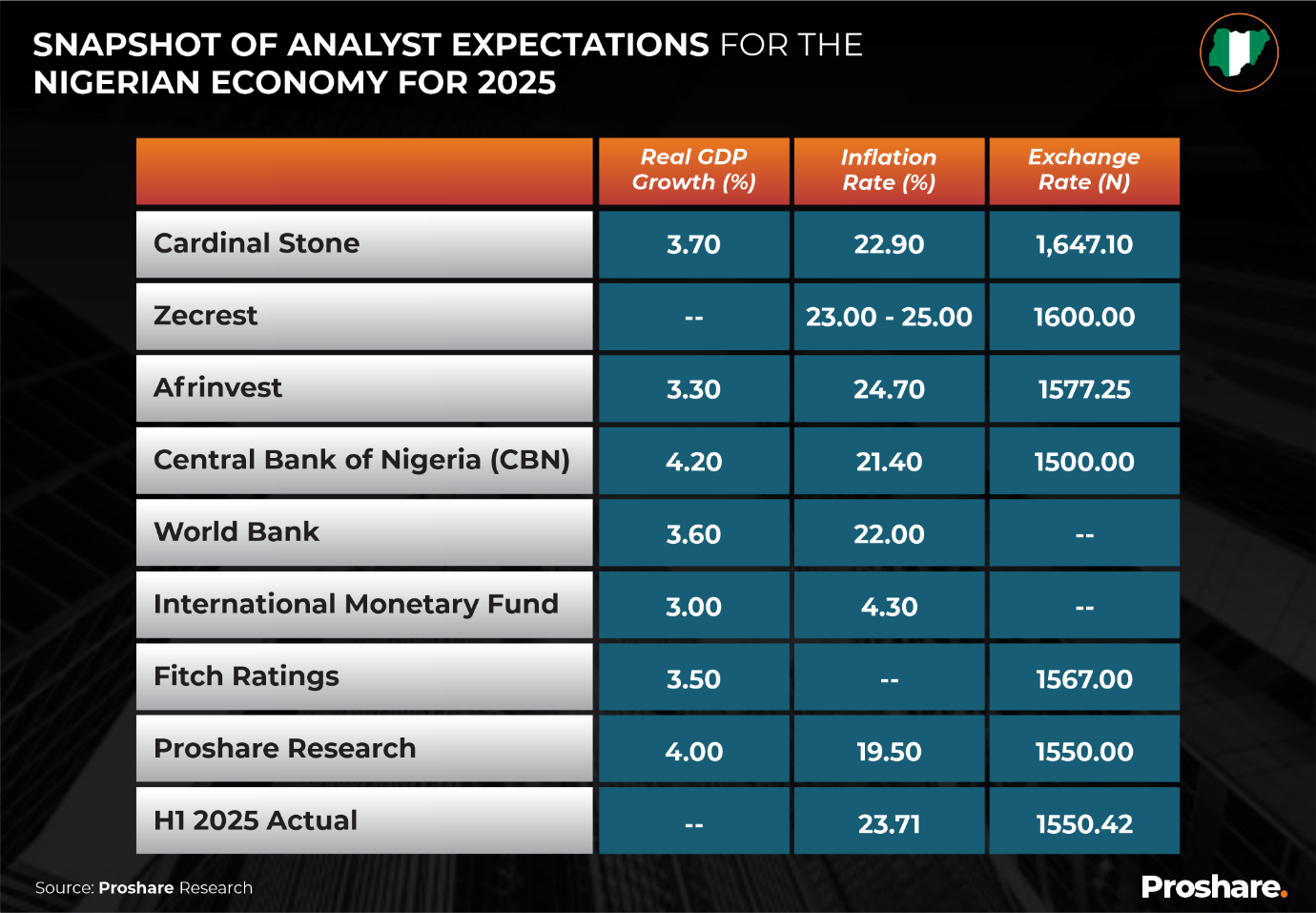
Nigeria Microeconomic Dashboard and Outlook for H2
The gradual yet suboptimal sense of normalisation that has swept through the microeconomic landscape in H1 2025 is indicative of increasing expectations among microeconomic agents for the potential positive outcomes from the government’s ongoing reforms and policy actions. Notably, overall food prices have marginally moderated but remain elevated, wages have increased but fall behind inflation-adjusted wage levels, and energy costs were higher in the period; however, the activities of the Dangote Petroleum refinery have ensured the availability of refined petroleum products and announced free nationwide distribution by Q3 2025 increasing possibilities of marginal price moderation in H2 2025.
The implementation of interventions such as conditional cash transfers and the student loan programme has so far reached only a limited segment of the population and has had a modest impact relative to the scale of economic hardship triggered by the removal of the petrol subsidy in 2023. While the government has acknowledged that the broader and more sustained effects of its reform agenda will require a transition period before households and businesses feel tangible improvements, Proshare analysts emphasise the importance of clear policy signalling and communication.
This is essential to provide the public with a realistic expectation of the timeline within which positive, widespread outcomes or macroeconomic stability may materialise on the state of the microeconomy. The analysts further underscore the need for transparent data disclosures to facilitate the evaluation of the effectiveness and reach of ongoing government reforms (see Illustration 5 below).
Illustration 5:

Fiscal and Monetary Review and Outlook for H2
Nigeria generated approximately N6.9trn between January 2025 and April 2025, compared to N5.2trn in the same period last year, according to Finance Minister Wale Edun’s fiscal performance review. Within the period in 2025 total public debt rose by 4.72trn to reach N149.39trn despite which global rating agencies review Nigeria’s sovereign ratings upwards (see Chart 2 below).
Chart 2:

Questions remain due to observed fiscal vulnerabilities in H1 2025, majorly around the ability of the government to substantially implement its N54.99trn appropriation plan, a concern raised by Proshare analysts earlier in the year and recently raised by the IMF in its Article IV report.
Oil revenue accounted for 43.9% of the 2024 budgeted revenue which has had its capital component extended for the second time till December 2025 due to revenue short falls. Oil revenue also accounts for 56%of the government’s 2025 budgeted revenue target in which most of the projected assumptions remain misaligned with reality. These risks may lead to increased reliance on debt financing, constraining the government’s ability to implement the 2025 budget fully, thereby increasing the likelihood of repeated fiscal cycle extensions (see Illustration 6 below).
Illustration 6:
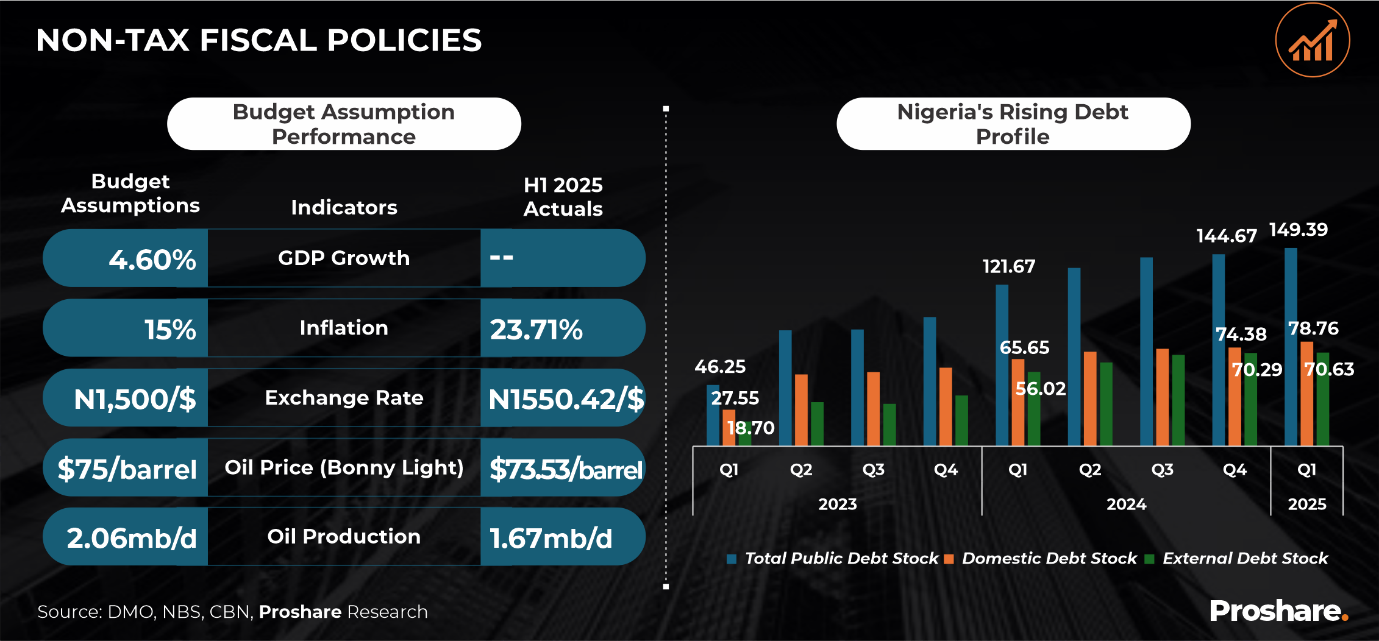
Nigeria’s President Tinubu signed the four tax reform bills into law on Thursday, June 26, 2025. The bills include the Nigeria Tax Administration Bill 2025, the Nigeria Tax Bill, which will have the most significant impact on Nigerians, the Joint Revenue Board (Establishment) Bill, and the Nigeria Revenue Service (Establishment) Bill, 2025. President Tinubu has described the new tax laws as “pivotal to the success of the administration’s reforms and the country’s prosperity.”
Similarly, the chairman of the Presidential tax reform committee, Mr. Taiwo Oyedele, has noted that the new tax laws which come with an “overriding principle of fair taxation” will have an immediate impact on the economy upon implementation in January 2026, yielding fruits such as investment surge, incentivising households consumption, formalising the informal businesses, eliminating the opaque and convoluted tax regime with multiple taxation. Diverging views note gaps and raise concerns on the ability of the tax laws to drive productivity across sectors, as well as the constraints the tax laws will have on small businesses in Nigeria, as the tax base has been lowered to N60,000. Overall, the emergence of the new tax laws is expected to send positive fiscal signals to investors and markets. Proshare analysts note the need for foresight in managing post-reform risks upon implementation in January 2026 (see Illustration 7 below).
Investment
Illustration 7:

Monetary policy actions focused on sustaining price and FX stability in H1 2025. The CBN Monetary Policy Committee (MPC) held the policy interest rate at 27.50% at its two meetings in the first half of the year amid signs of moderating inflation conditions. Despite elevated rate conditions, the period was marked by weak capital flows into the economy, with direct investment stock declining to $0.25bn in Q1 2025 from $0.31bn in Q4 2024, and the inflow of portfolio liabilities dipping by over $5.03bn in Q1 2025, according to the CBN BoP report. Weak global oil prices, due to global geopolitical and geoeconomic disruptions, impacted FX inflows from oil sales, thereby affecting gross reserve liquidity.
However, the CBN has signalled plans to diversify its reserve base—a strategic step aimed at mitigating currency risk, reducing exposure to external shocks, and supporting FX market stability. We maintain our earlier projection for a policy rate cut in Q4 2025, as outlined in our 2025 macroeconomic outlook. However, we recommend a downward adjustment of the Cash Reserve Ratio (CRR) in Q3 2025 to ease liquidity pressures on real sector lending conditions (see Chart3 below).
Chart 3:
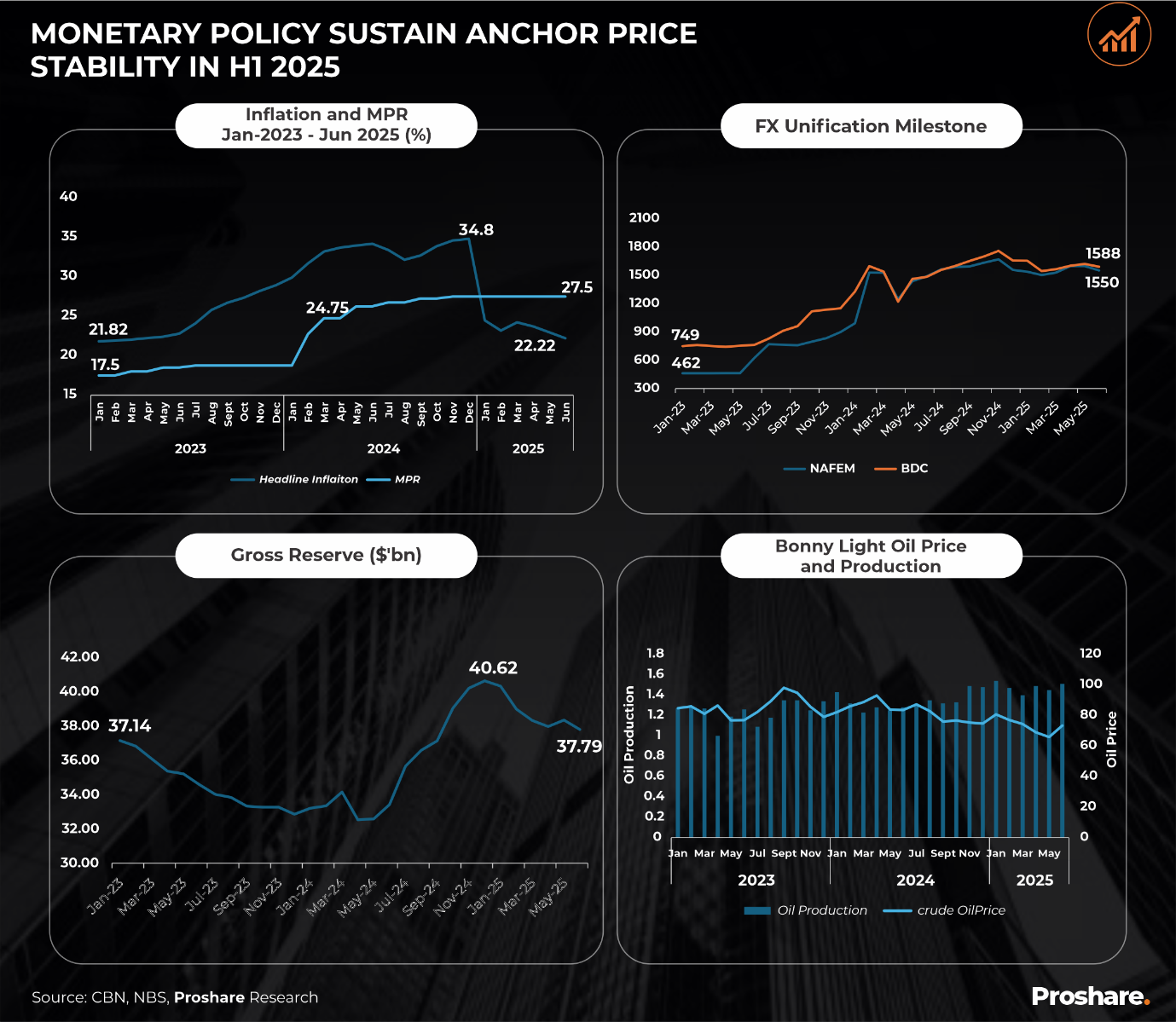
Sectoral Growth Review and Outlook for H2
Sectoral activities in the economy and across markets showed notable expansion in the first half of 2025. Key indicators such as the PMI revealed an expansion across all economic sectors with private sector activities across the agricultural, industrial, manufacturing and services sectors all averaging above the 50-mark threshold for the first time in the last three years. This performance is due to marginal moderations in overall price levels, stable FX market conditions, stronger demand, higher levels of new orders and output levels, and growth in employment levels across sectors suggesting that the high GDP growth performance observed in previous quarters will persist through in H1 2025.
Similarly, most sectors across the equities market showed expansion above the all-share index performance with a half-year-to-date (YTD) growth of 16.57% while the Oil and Gas Index remained negative, declining by 10.12% trailing on behind the 160.00% recorded in 2024 amidst weak global oil market conditions (see chart 4 below).
Chart 4:
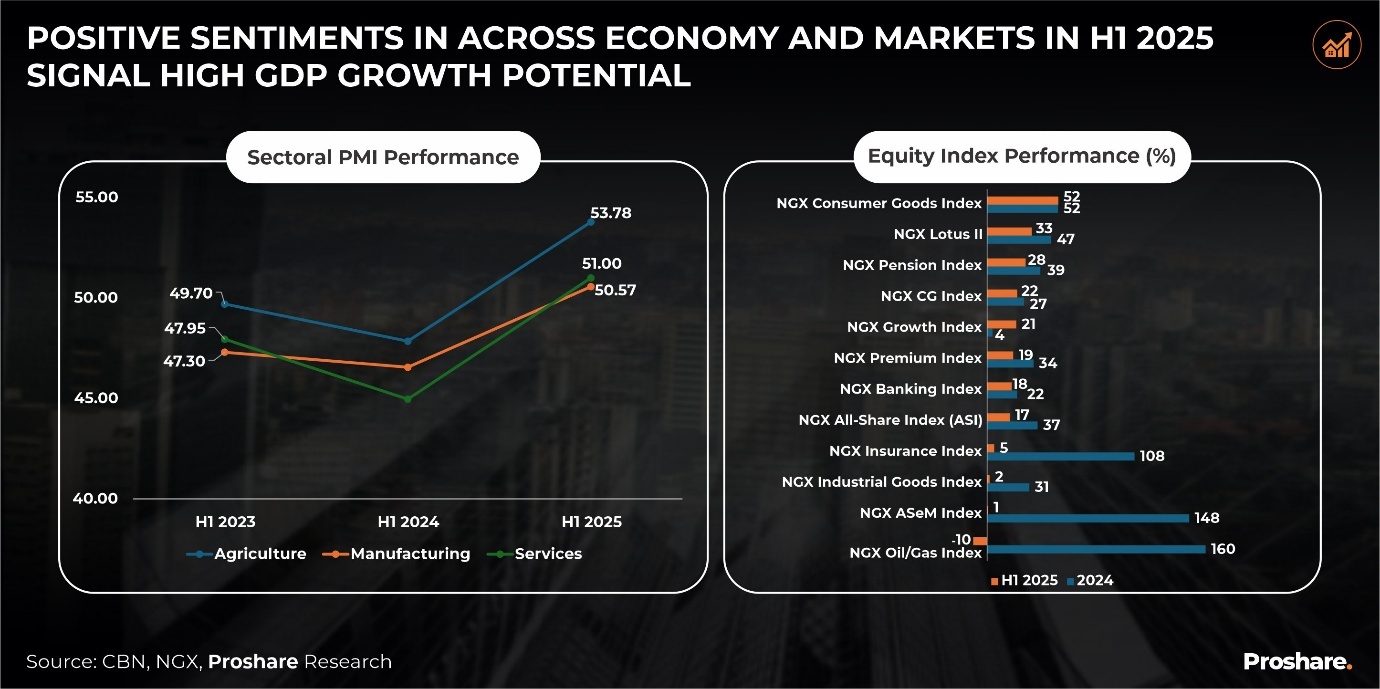
External Market Exposures and Liquidity Flows for H2
The performance of external economic and market indicators was key to the stability conditions observed in the Nigerian economy in 2024; however, the positive trends in inflows and external account balances reversed at the onset of 2025 due to the instability posed by global geoeconomic and geopolitical tensions, resulting in a rise in levels of uncertainty. Specifically, liquidity conditions and overall balance of payment accounts were weaker exposed to risks due to;
- Weak global oil prices in H1 2025.
- The US announced 14% reciprocal trade tariff on Nigeria in April 2025.
- Threats of higher trade tariffs on BRICS+ nations and partners.
- The US, in its ‘One Big Beautiful Tax Bill’ recently signed into law, includes a 1% tax on remittances.
- Low inflows from aids and grants attributable to US executive order by Donald Trump in addition to already existing higher interest payment rates to non-resident investors (see chart 5 below).
Chart 5:
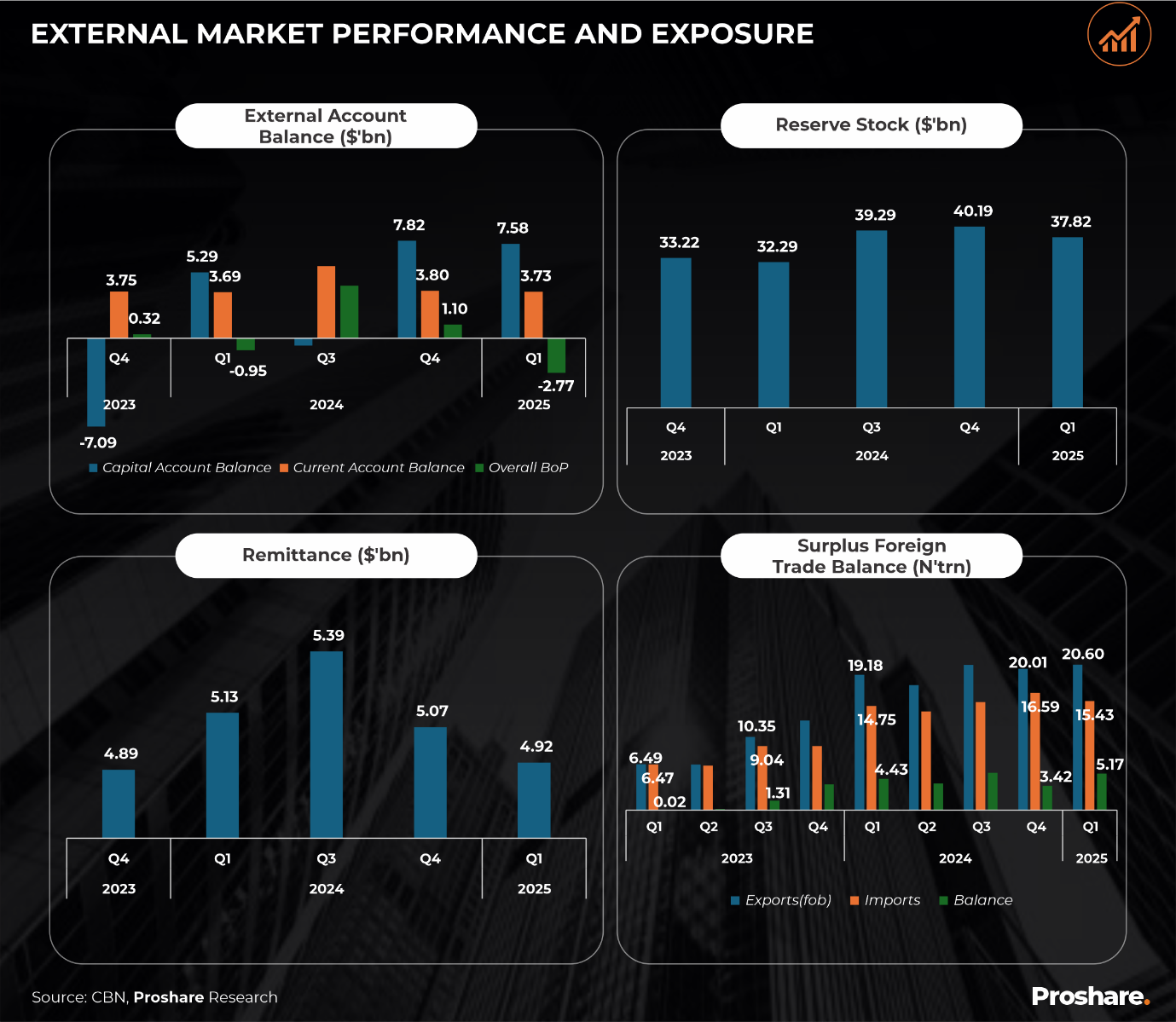
Trade shifted from a multilateral to a protectionist system earlier in the year, with most nations now seeking bilateral deals and access to alternative markets. Nigeria achieved notable gains from non-oil trade, intra-African trade expansion, and policy shifts, which are expected to sustain the trade surplus throughout H2 2025 and boost intra-African trade under the AfCFTA.
- Nigeria reported the tenth consecutive quarter of surplus trade balance at $5.17trn in Q1 2025.
- The Nigeria–East/Southern Africa Air Cargo Corridor was launched to operationalise the African Continental Free Trade Area (AfCFTA), giving exporters access to the Uganda, Kenya, and South Africa markets at a lower cost
- The CBN released the simplified review of documentation requirements for transactions conducted through the Pan-African Payment and Settlement System (PAPSS) in Nigeria.
- Nigeria Gazettes AfCFTA Provisional Schedule of Tariff Concessions (PSTCS)
- China, which announced a zero-tariff policy granting duty-free access to all 53 African countries
- The UK announced that it will grant duty-free access to over 30 African countries, including Nigeria, which would get 99% duty-free access on all of its exports to the UK.
GDP Rebasing: Of Stale Expectations and Data Credibility
Nigeria’s National Bureau of Statistics (NBS) proposed releasing the country’s rebased GDP figures by January 2025; however, the rebased data remains undisclosed. We expect the data to be released sometime in the second half of the year. The bureau’s recalibration, which updates the base year from 2010 to 2019, also aims to capture the evolving structure of the Nigerian economy, including the growth of underrepresented sectors such as the creative economy, digital services, and other evolving sub-economies. According to the NBS, the activities of some sectors of the economy have grown tremendously since the last rebasing, making them significant among other sectors of the economy. They include Marine and Blue Economy; Art, Culture, Tourism and Creative Economy; Information and Communication Technology; Innovation and Digital Economy; and E-activities. These developments need to be adequately captured in GDP compilation.
The 2014 rebasing, which highlighted telecommunications and entertainment as key growth drivers, revealed a GDP increase of about 90%, positioning Nigeria as Africa’s largest economy, surpassing South Africa, with a GDP of US$510bn. In pre-empting the rebased GDP, Proshare analysts extrapolated that the 2024 GDP could rise to about US$490bn from US$161bn under the old base and classification, exchange rate of about N1,500/US. This would narrow the gap between the current state and the aspirational US$1trn by 2030 and align the country’s data with international best practices, as recommended by the United Nations to rebase every five years.
Despite its benefits, rebasing does not automatically translate to improved living standards. The 2014 rebasing, while showcasing a larger economy, did not alleviate poverty or unemployment, which further fuelled public scepticism about official data. Nigerians have often felt a disconnect between reported figures and their everyday experiences. For instance, the rebased CPI figure lowered inflation, but market reality suggests over 100% loss of purchasing power, and essential goods becoming luxury items. The revenue-to-GDP ratio, already below 10%, will appear even worse post-GDP rebasing in H2 2025, exposing weak tax collection that necessitated the Tax Reform Act. The implementation of the new tax act may be a cushion for revenue improvement in 2026, depending on the commitment from relevant MDAs. Additionally, a lower debt-to-GDP ratio might create an illusion of fiscal space, tempting excessive borrowing, while developmental investment in key infrastructure and growth enablers may shrink relative to a larger GDP unless actual investments increase.
Delays in economic data reporting, particularly the rebased GDP, have raised concerns about institutional capacity and data integrity. On the one hand, public trust wanes when figures fail to reflect realities at marketplaces, for instance, where vendors lament a doubling of prices but official data reports one-fourth growth in prices. On the other hand, the failure to report it at the appropriate time also amplifies the concerns about data accuracy and consistency. Timely and transparent communication is crucial to bridge the gap between statistical recalibrations, public perception, and investment inflow. Proshare analysts have argued that while the organisation, NBS, has done a good job in upgrading its surveys and adopting newly designed data-gathering and analytical templates, the speed and availability of the data survey outcomes require attention.
Tracking 2 Years of Renewed Hope Agenda: Reform Transition Gaps
Nigeria’s macroeconomic environment in 2025 has featured a combination of reform-driven optimism and persistent challenges. At the H2 2025 Economist Conference, themed: Reform Path and Transition Gaps: The Economics of Renewed Hope, economists, policymakers, private sector leaders and stakeholders reviewed the progress of reforms over the last two years while also offering insights and actionable solutions necessary to bridge the gap between policy and practice to ensure that economic reforms transition into tangible gains for households and the nation. The panel session featured four discussants with consensus in areas including;
- Nigeria has achieved macroeconomic stability; however, there are gaps, especially in elevating household welfare and supporting business investment growth.
- Monetary policy efforts of the CBN have been key to ongoing stability; however, fiscal policy lags.
- Capital projects need alternative financing options over dependence on debt and budgetary funding.
- There is a need for adequate communication and credible data disclosure to Nigerians on reforms.
- Boosting revenue and long-term investment inflow is crucial to sustaining stability.
In many realms of economic reform, it may take longer than two years to act and implement reforms, according to Dr Ayo Teriba, CEO, Economic Associates. For Nigeria, the Tinubu administration’s reforms, after two years in office, have yielded lasting gains through reforms in the foreign exchange and energy sectors. FX unification has brought much-needed macroeconomic stability, while cost-reflective reforms in the energy and telecom sectors have helped businesses thrive, supporting activities of players like Dangote Refinery in offering lower energy prices. Yet, momentum stalls elsewhere.
Conversely, Fiscal reforms remain underwhelming, with ballooning debt casting doubt on revenue claims. Dr Teriba expressed little optimism over ongoing tax reforms, noting that the tax reforms have so far, “…been in the rhetoric…not touched on any reality, … and been a jolly ride to nowhere,” thus, unlikely to bear fruit before the next election. Transportation reforms face funding gaps, underscoring the urgent need for non-debt financing and the necessity of leveraging idle national assets. At the state level, governments remain mainly on the sidelines, impacted by federal reforms but powerless to shape reforms, leaving states in the passenger seat of Nigeria’s reform journey. States must, however, offer support to the federal government to realise gains from reforms.
Countering Dr Teriba’s low optimism about the positive gains from tax reforms, Dr Tope Fasua noted that reforms such as tax reform are pro-poor and will alleviate the challenges faced by lower-income households. On issues of debt, he adds that, Nigeria is not overborrowed. Dr Fasua, Special Adviser to the President on Economic Matters, described ongoing reforms as both unpopular and necessary, resulting in higher foreign reserves, an improvement in sovereign ratings, and FX market stability, as well as a trade surplus recorded in the last two years. While noting the resultant gains in the oil sector, where Nigeria has become a net exporter of refined products, Dr Fasua also pointed to the improvements in non-oil exports. The Economic Adviser questioned the credibility of rhetoric on issues such as growing poverty levels. To facilitate the transition to micro-level reform, there is also a need for Direct advocacy, increased public-private partnership, private sector compliance, and liquidity at the state level. “This is not the time to change course nor policy, but a time to guide policy,” according to Dr Fasua.
Mr Yomi Olugbenro, Partner & West Africa Tax Leader at Deloitte, and a member of the Presidential Tax Reform Committee, asserts that Nigeria’s macroeconomic conditions are undergoing a corrective shift with unavoidable resultant pains. Nigeria must capitalise on the gains made so far at the macro level to transition benefits to households. Sharing in the Optimism of Dr Tope Fasua on the impact of Tax reforms, Mr Yomi noted that the benefits will be immediate, medium-term, and long-term, offering fairness and equity and incentivising businesses and households. The six-month implementation delay of the new Tax Acts following their signing into law is in accordance with the country’s tax provisions, enabling adjustments by all stakeholders. Multilingual communication and capacity building remain vital to the implementation process of tax reforms. Mr Olugbenro noted that businesses must engage in impact assessment and capacity building and engage with service providers to facilitate the transition to the new tax regime. Implementation is key to realising the gains from tax reforms. Not much will be achieved if implementation is not practical, according to Mr Yomi.
According to the Deloitte tax chief, the AfCFTA offers a huge opportunity for local industries in Nigeria to operate on the continental stage due to provisions such as zero duty on about 90% of goods over the next 5-10 years. Nigeria must optimise production, invest in infrastructure, enable ease of doing business, ensure proper border management, and support local manufacturing activities to be competitive to leverage the gains from AfCFTA opportunities.
Financial consulting
Mr Teslim Shitta-Bey, Chief Economist, Proshare Nigeria, stressed that, beyond the need for implementing reforms, there is a requirement for effective communication of policies and reforms, such as tax reforms, to households and businesses. Mr Teslim aligned with the views of Dr Ayo Teriba, expressing concerns over the limited impact of fiscal policies in boosting revenue and sustainable project financing suggesting the need the leverage equity-based financing and calling for another “GSM moment” like the telecom sector’s past boom. He advocated for a national asset register and an investor-friendly deal room to attract capital, while also urging Nigeria to fully leverage its capital markets and explore tools like municipal bonds at the subnational level. These strategies, he argued, are crucial to unlocking foreign exchange inflows, strengthening reserves, and promoting genuine economic growth. While commending the CBN’s progress on price stability, he noted the need to ease monetary constraints, particularly by reducing the CRR, to revive lending to the real sector (see Table 5 below).
Table 5
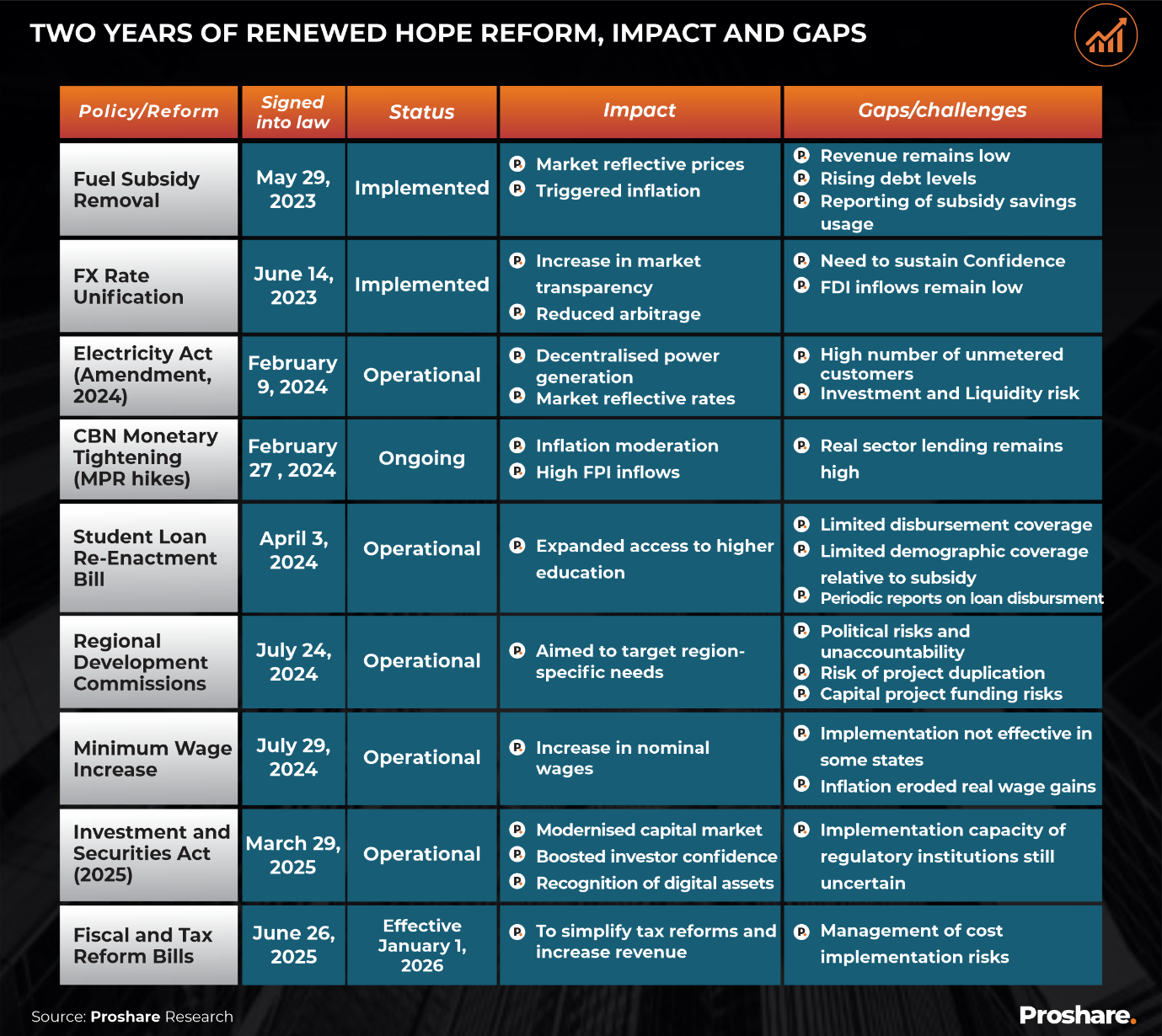
Closing Thought
The global economy has been whiplashed by a variety of events, ranging from the global tariffs imposed on countries by the US government in 2025 and a slowdown in growth rates across continents because of supply chain disruptions and rising input prices, except for a few Asian and mid-sized countries in sub-Saharan Africa (SSA). The consequences are a forecast of slower global growth, which is expected to continue into 2026.
Nigeria is expected to see gross domestic product growth of around 3.5% in 2025 and 3.7% in 2026. Exchange rate stability, lower inflation rate (after CPI rebasing), and rising crude oil output would likely undergird the relatively strong growth of the economy in H2 2025.
The Nigerian economy will progress steadily in H1 2025, with the key highlights being:
- Faster-paced GDP growth of between 3.5% and 3.7%
- Domestic inflation is expected to fall steadily towards 21% or lower over the next five months
- Increase in net reserves to between US$25bn and US$27bn by the year end. Expected gross GDP would likely settle between US$39 and US41bn.
- Monetary policy rate (MPR) will remain at 27.5% as the Central Bank of Nigeria (CBN) sticks to an aggressive anti-inflationary stance, however Cash Reserve Ratio (CRR) may be reduced modestly from the present 50% to 45%.
- The Naira to dollar rate may stay within a N1,550/$ to N1,600/$ bond. Some financial analysts have projected the rate to slip to N1,700/$ by the year end but much of the likely year end exchange value of the Niara will depend on international oil prices and the production of crude oil.
The outlook for the Nigerian economy is sober. Our analysts do not expect any major deterioration of economic conditions but the pace of GDP growth and the rise in inflation rate requires a major correction to pull more Nigerians out of the poverty bind. Households are still squeeze to the bones, and life for many remains harrowing. The federal government has done a brave job in stabilizing the economy, but for the remaining eighteen months it needs to build a raft of prosperity that carries all citizens. The governments performance in the past two years have been courageous, but the actions over the next two years need to be constructive
Adapted from the Proshare




